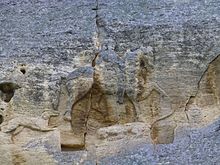Madara Rider
| Madara Rider | |
|---|---|
| Name as inscribed on the World Heritage List | |

The Madara Rider
|
|
| Criteria | i, iii |
| Reference | 43 |
| UNESCO region | Europe |
| Coordinates | 43°16′36.1″N 27°07′10.4″E / 43.276694°N 27.119556°ECoordinates: 43°16′36.1″N 27°07′10.4″E / 43.276694°N 27.119556°E |
| Inscription history | |
| Inscription | 1979 (3rd Session) |
The Madara Rider or Madara Horseman (Bulgarian: Мадарски конник, Madarski konnik) is an early medieval large rock relief carved on the Madara Plateau east of Shumen in northeastern Bulgaria, near the village of Madara. The monument is dated in the very late 7th, or more often very early 8th century, during the reign of Bulgar Khan Tervel. In 1979 became enlisted on the UNESCO World Heritage List.
The relief depicts a majestic horseman 23 m (75 ft) above ground level in an almost vertical 100 m (328 ft)-high cliff. It is of almost natural size. The horseman, facing right, is thrusting a spear into a lion lying at his horse's feet, and on the left a dog is running after the horseman. The carving of the horseman halo, garments, as well the bird in front of the horseman face, are barely recognizable due to the erosion and bad condition of the monument. The relief is similar to the carbon images found in Saltovo, Soulek, Pliska and Veliki Preslav.
The meaning and sybolism of the depiction is uncertain, as well its actual masonry tradition and cultural source.
In the scholarship the origin of the relief is connected with the Bulgars ethnogenesis – the semi-nomadic equestrian warrior culture from the Eurasian Steppe. Others saw in the relief resemblance to the Sasanian rock relief tradition. The hero-horseman is a common character of Turko-Altaic and Alanic mythology. It is sometime considered that the horseman represents or is related to the Bulgar deity Tangra, while Vladimir Toporov related it to the Iranian deity Mithra.
...
Wikipedia

